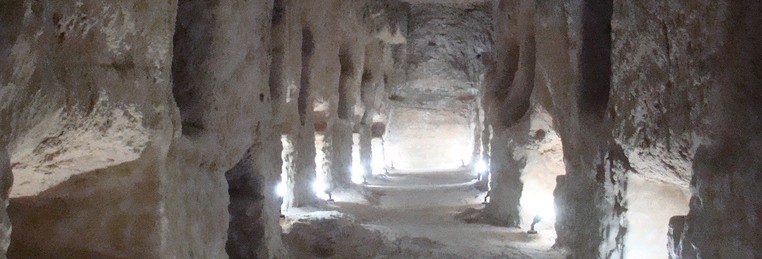The Ptolemaic king responsible for building the Serapeum in Alexandria is Ptolemy I Soter, while Ptolemy II Philadelphus is credited for bringing the cult statue of Serapis to the temple in either 286 or 278 BC; “when Ptolemy I Soter (reigned 305-284 BC) wanted to select an official god for Egypt, he chose Serapis, ordering his architect Parmeniscus to design what became one of the largest and best known of the god’s temples.”1 According to archaeological evidence, the Serapeum was used as a sanctuary by the first quarter of the third century BC; it was also dedicated to Isis and Serapis during the reigns of both Ptolemies.
While the Saqqara Serapeum contained Greek elements in an Egyptian context, the Alexandria Serapeum included Egyptian elements in a Greek setting. There is little evidence involving the architectural style of this Serapeum, and traditional speculation has focused on a Greek-style reconstruction, most likely with some Egyptian elements. The Ptolemaic Serapeum of Alexandria had more Egyptian features than the Roman Serapeum did.
It turns out that both the Ptolemaic and Roman Serapea were rectangular in appearance; however “the older Enclosure consisted of outer walls and inner parallel colonnades, the foundations for all of which were sunk in the rock”2. Actually, it was in a hole in the rock below the junction of the south and east outer walls that the first set of plaques were found; the second set of plaques came from an identical position below the outer walls at the south-west angle.
Both the Ptolemaic and Roman Serapea were approached from the side rather than from an axis, and each also contained a Nilometer. A Nilometer is “a well with measurements marked on it, or a measuring stick, for measuring the height of the annual flood of the Nile River.”3 After the end of Ptolemaic rule in Egypt, the Romans built over the Ptolemaic Nilometer but did not replace the Temple of Harpocrates, which probably served as a birth house. Archaeologists have not been able to find the Roman Nilometer. The Nilometer would play a role in the attempt to restore paganism in Egypt following the destruction of the Roman Serapeum; “it is mentioned in AD 362 when, while attempting to restore paganism, the emperor Julian transferred the Nilometer, symbols (symbola), and (tablets with) the ancestral customs (ta palaia patria) back to the Serapeum because Constantine had moved them to a church.”4
The Ptolemaic Serapeum had two underground tunnels, one of which has been identified as being part of the library of the Serapeum. Archaeologists believe this because of the niches found on the walls, supposedly intended to hold papyrus rolls; “more likely the niches would have held funerary urns containing sacred animals and birds.”5
Pompey’s Pillar, also known as Diocletian’s Column, is a huge monolith of red Aswan granite that can be found on the site of the Alexandria Serapeum; it was built in about 300 AD in honor of Diocletian, the Roman Emperor who saved the city from famine after suppressing an eight-month rebellion. Medieveal travelers falsely believed that the column marked the gravesite of the Roman general Pompey, who was murdered in Egypt in 48 BC where he had fled after his defeat by Julius Caesar in the civil war. Diocletian’s Column is the largest column in the Greco-Roman world as well as the only ancient monument still standing in Alexandria; “the column with its base and Corinthian capital is twenty-seven meters high, and the shaft is nine meters in circumference”.6
1.Encyclopedia Brittanica- Serapeum (ancient temples, Egypt) http://www.britannica.com/EBchecked/topic/523962/Serapeum
2.Rowe, Alan, and Etienne Drioton. Discovery of the Famous Temple and Enclosure of Serapis at Alexandria,. Le Caire: Impr. De I’Institut Français D’archéologie Orientale, 1946. 3
3.McKenzie, Judith. the Architecture of Alexandria and Egypt: 300 BC- AD 700. New Haven: Yale UP, 2011.447
4. McKenzie, Judith, Sheila Gibson, and A. T. Reyes. “Reconstructing the Serapeum in Alexandria from the Archaeological Evidence.” The Journal of Roman Studies 94 (2004): 73-121. 96.
5.Haag, Michael. Alexandria Illustrated. Cairo; New York: American University in Cairo Press, 2004. 34
6.Ibid 35


